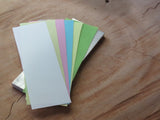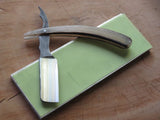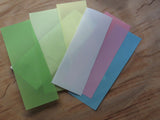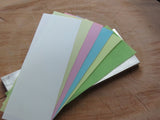Using lapping film to maintain and sharpen your razor is a fairly cheap way to do so, a collection of whetstones or natural sharpening stones will cost anything from R5k for a basic setup and can quickly shoot up into the tens of thousands of rands range when you start collecting natural stones or a variety of synthetic hones.
Lapping film will do much the same job as a whetstones, but it does not have the lifespan, and is a bit more cumbersome to use in that you have various 'layers' or mediums you are using at any given time.
You'd normally have the lapping film right on top 'doing the work' when your razor is run over this. The film is set onto a flat based surface by means of using some water in a spray bottle, this will cause the shiny, smooth backside of the film to 'stick' to the base. As a base some folks use glass, a tile or granite, we prefer our aluminium base plate as it is fairly light, strong, unbreakable when dropped and perfectly flat. You will also find some users suggesting to use some newspaper in between to take up minor indents or defects that might be present on the base surface of choice, you will probably feel the same way as the sensation of the razor on the film is very 'direct' and hard, one gets the impression even a fine speck of dust could have an effect on the bevel or edge (apex) We used copy paper, as 80 gram bonded paper have fillers in them to achieve a certain amount of smoothness required by production quality procedures, so it seemed a more sensible option.
Each film should give you anything from 10 to 20 uses, obviously some grits will get 'more work' than others, mostly the higher end grits will get used up quicker as they will be used to 'refresh' the blade, in most cases it will not be a requirement to reset the bevel using the lower end grits, and they should last longer.
Try and buy a full set to get going and top up on individual strips as required. The grits/coding per colour are as follows;
IVORY = .3 micron = ~60,000 grit
Green = 1 micron = - 14000
PINK = 3 micron = ~7000 grit
BLUE = 9 micron = ~1800 grit
Yellow = 12 micron = ~1200 grit
Dark Green = 30 Micron 600 grit
There are a few videos available that gives some direction, if you are someone who tend to be a bit heavy handed you may want to change the methodology from what is shown in the videos and rather start with edge-tailing strokes rather than edge leading strokes, this will prevent you from cutting the film until you have found your rhythm in using this method.








